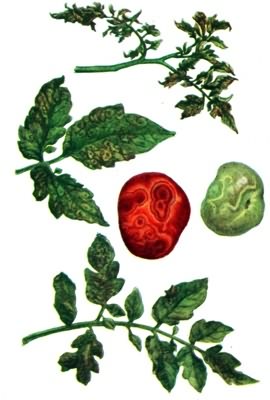Diseases
Tomato spotted wilt tospovirus - Tomato Spotted Wilt Virus (TSWV)
Systematic position.
Kingdom Vira, genus Tospovirus.Synonyms.
Tomato virus Jonson, Licopersicum virus 3 Smith, Labilococus solani Procenko, Dahlia oakleaf virus, Dahlia ringspot virus, Dahlia yellow ringspot virus, Groundnut ringspot virus, Mung beanleaf curl virus, Pineapple yellow spot virus, Watermelon silver mottle virus. ICTV decimal code 11.0.5.0.003.Biological group.
Biotroph.Morphology and biology.
In the majority of attacked cultures, TSWV causes such symptoms on test host-plants as local necrotic spots and systemic necrotic patterns, deformation of leaves and wilt. Host-plants susceptible to the virus belong to more than 9 families. TSWV has spherical particles of 85 nm in diameter; temperature for the virus inactivation is 40-50°C, limiting dilution is 1: 100, loss of infectivity in sap is 5 hours. TSWV belongs to a group of pathogens forming natural foci, which is one of the most widespread and harmful phytoviruses. TSWV spread in nature is realized by means of Thrips tabaci, a vector of the virus. More than 20 thrips species (Thysanoptera) are known to transfer the virus from wild-growing plants to cultural ones. In the territory of the former USSR, the main vector the virus is Thrips tabaci. This vector catches the virus in the larva phase and keeps it until the end of life. The virus propagates within the vector, and is transferred by mechanical inoculation; however, it is not transferred by contact, on seeds and pollen.Distribution.
The virus is probably distributed worldwide and is recorded in more than 70 countries. In the former USSR, TSWV was first registered in Georgia (Eristavi, 1941). The Virus is distributed everywhere in the entire territory of the European part of the former USSR. The disease is revealed in Azerbaijan, Ukraine, Krasnodar Territory, Volga Region, Crimea, Armenia, Turkmenistan, and Moldova. The virus is recorded in more than 70 countries of the world.Ecology.
Distribution of TSWV is mainly determined by the presence of natural foci and by the number of thrips-vectors; population density of the latter depends on ecological factors.Economic significance.
Broad specialization of TSWV allows infecting of many cultural plants; however, the harming activity of the virus is documented on tomato, pepper, and tobacco plants. TSWV is especially harmful in Crimea, the Northern Caucasus, Krasnodar Territory, Rostov Region. Control measures should basically include chemical treatments against Thrips tabaci (vector) and weeds (natural sources of the virus).Reference citations:
Asatryan E.V., Babayan A.A. 1962. Bronzing of tobacco in Armenian SSR. Izv. AS Armenian SSR. Biol. Science (Yerevan) 15(8): 57-64 (in Russian).Brunt A.A., Crabtree K., Dallwitz M.J., Gibbs A.J., Watson L. & Zurcher E.J., eds. 1996-2006. Plant Viruses Online: Descriptions and Lists from the VIDE Database. Version: 20th August 1996. URL http://biology.anu.edu.au/Groups/MES/vide/
Dashkeeva K.N., Moldovan M.Ya., Popushoi I.S. 1971. Diseases and pests of tobacco in Moldova. AC Moldavian SSR. Kihsinev. p. 67 (in Russian).
Goncharova M.P. 1960.Tomato Bronzing on tobacco in the West of Ukraine. In: Virus diseases of plants and measures of their control. Moscow, p.178-183 (in Russian).
Eristavi E.M. 1941. Virus diseases of plants in Georgian SSR. In: Ryzhkov V.L., ed. Virus diseases of plants and measures of their control. Tr. soveshch. Moscow & Leningrad: AS USSR, p. 294-308 (in Russian).
Eristavi E.M. 1960. Results of Researches of plant virus diseases in Georgia. In: Virus diseases of plants and measures of their control. Moscow, p. 50-58 (in Russian).
Khudyna I.P. 1936. Virus diseases of tobacco in the USSR and measures of their control. In. Dunin M.S., ed. Virus diseases of plants. Moscow & Leningrad, p. 32-41 (in Russian).
Matveenko T.M., Goncharov M.P. 1963. Struggle with severe bronzing of tomatoes on tobacco. J. Tobacco 1: 35-37 (in Russian).
Moldovan M.Ya., Chokan N. 1974. Virus of bronzing of tomatoes on tobacco in Moldova. In: Viruses and virus diseases of plants. Kiev: Naukova dumka, p. 239-242 (in Russian).
Popova A.A. 1960. Terminal chlorosis of tobacco and measures of its control. In: Sukhov, ed. Virus diseases of agricultural plants and measures of their control. Moscow, p. 170-177 (in Russian).
Samsonova L.N., Tsyplenkov A.E. & Yakutkina T.A. 2001. Diagnostics of virus and phytoplasma diseases of vegetable cultures and potato. Saint-Petersburg: VIZR, 50 p. (in Russian).
Sukhov K.S., Razvyazkina G.M. 1953. Terminal chlorosis of tobacco, its activator and vector. In: Nuzhdin N.I., ed. Trudy Institute of Genetics. V. 20. AS USSR, p. 270-282 (in Russian).
Tsyplenkov A.E. 1974. Identification of virus diseases of tomatoes in lower zone of Volga Region. In: Viruses and virus diseases of plants. Kiev: Naukova dumka, p. 251-254 (in Russian).
Vlasov Yu.I., Red.ko T.A., Lytaeva G.K. 1973. Virus diseases of vegetable cultures. Leningrad: Kolos, 71 p. (in Russian).
Vlasov Yu.I. & Larina E.I. 1982. Agricultural virology. Moscow: Kolos, p. 237 (in Russian).


